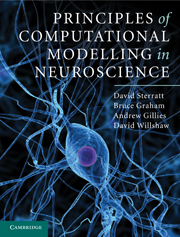Book contents
- Frontmatter
- Contents
- List of abbreviations
- Preface
- Acknowledgements
- Chapter 1 Introduction
- Chapter 2 The basis of electrical activity in the neuron
- Chapter 3 The Hodgkin–Huxley model of the action potential
- Chapter 4 Compartmental models
- Chapter 5 Models of active ion channels
- Chapter 6 Intracellular mechanisms
- Chapter 7 The synapse
- Chapter 8 Simplified models of neurons
- Chapter 9 Networks of neurons
- Chapter 10 The development of the nervous system
- Chapter 11 Farewell
- Appendix A Resources
- Appendix B Mathematical methods
- References
- Index
Chapter 1 - Introduction
Published online by Cambridge University Press: 05 June 2012
- Frontmatter
- Contents
- List of abbreviations
- Preface
- Acknowledgements
- Chapter 1 Introduction
- Chapter 2 The basis of electrical activity in the neuron
- Chapter 3 The Hodgkin–Huxley model of the action potential
- Chapter 4 Compartmental models
- Chapter 5 Models of active ion channels
- Chapter 6 Intracellular mechanisms
- Chapter 7 The synapse
- Chapter 8 Simplified models of neurons
- Chapter 9 Networks of neurons
- Chapter 10 The development of the nervous system
- Chapter 11 Farewell
- Appendix A Resources
- Appendix B Mathematical methods
- References
- Index
Summary
What is this book about?
This book is about how to construct and use computational models of specific parts of the nervous system, such as a neuron, a part of a neuron or a network of neurons. It is designed to be read by people from a wide range of backgrounds from the biological, physical and computational sciences. The word ‘model’ can mean different things in different disciplines, and even researchers in the same field may disagree on the nuances of its meaning. For example, to biologists, the term ‘model’ can mean ‘animal model’; to physicists, the standard model is a step towards a complete theory of fundamental particles and interactions. We therefore start this chapter by attempting to clarify what we mean by computational models and modelling in the context of neuroscience. Before giving a brief chapter-by-chapter overview of the book, we also discuss what might be called the philosophy of modelling: general issues in computational modelling that recur throughout the book.
Mendel's Laws of Inheritance form a good example of a theory formulated on the basis of the interactions of elements whose existence was not known at the time. These elements are now known as genes.
Theories and mathematical models
In our attempts to understand the natural world, we all come up with theories. Theories are possible explanations for how the phenomena under investigation arise, and from theories we can derive predictions about the results of new experiments.
- Type
- Chapter
- Information
- Publisher: Cambridge University PressPrint publication year: 2011



